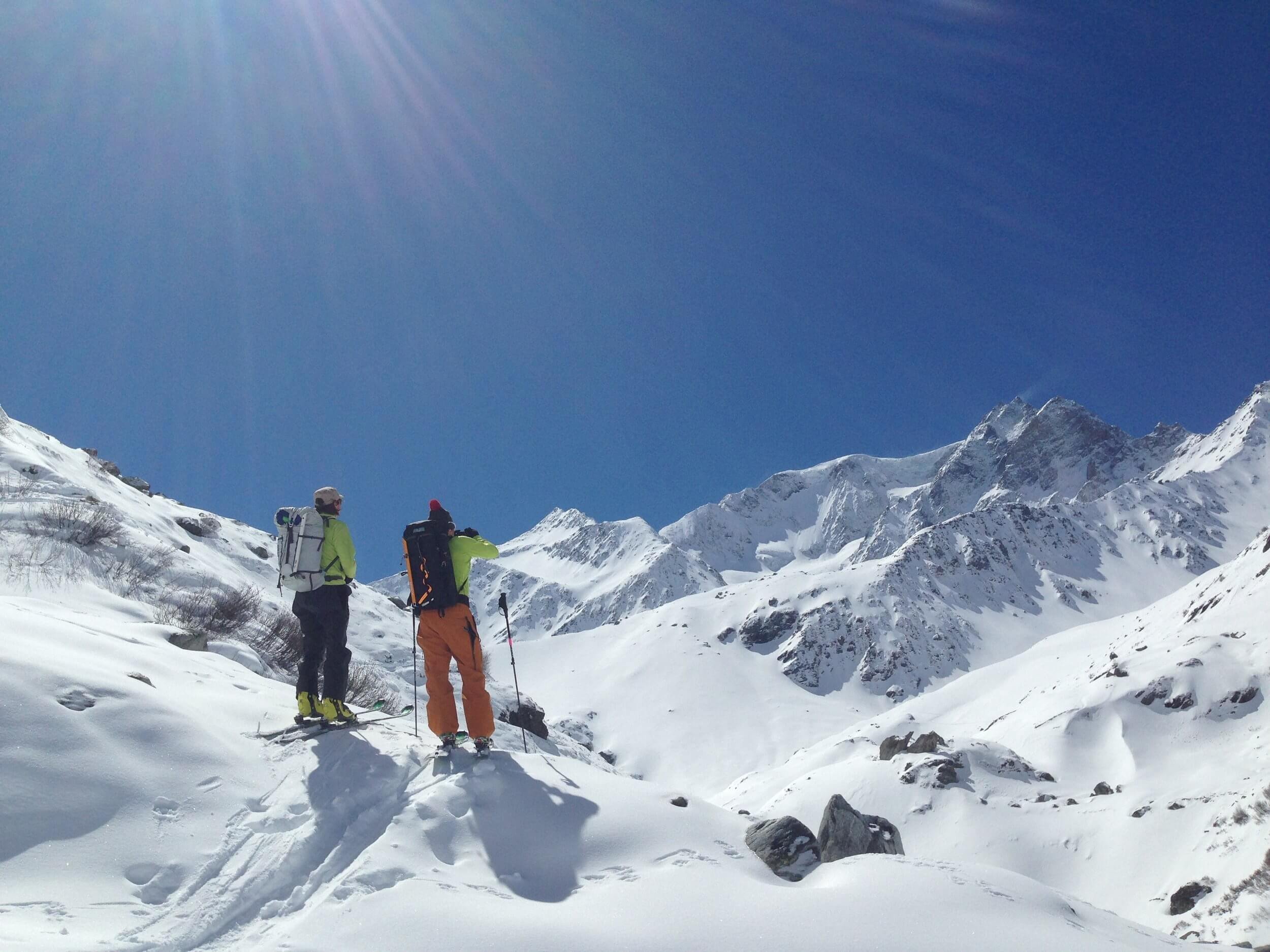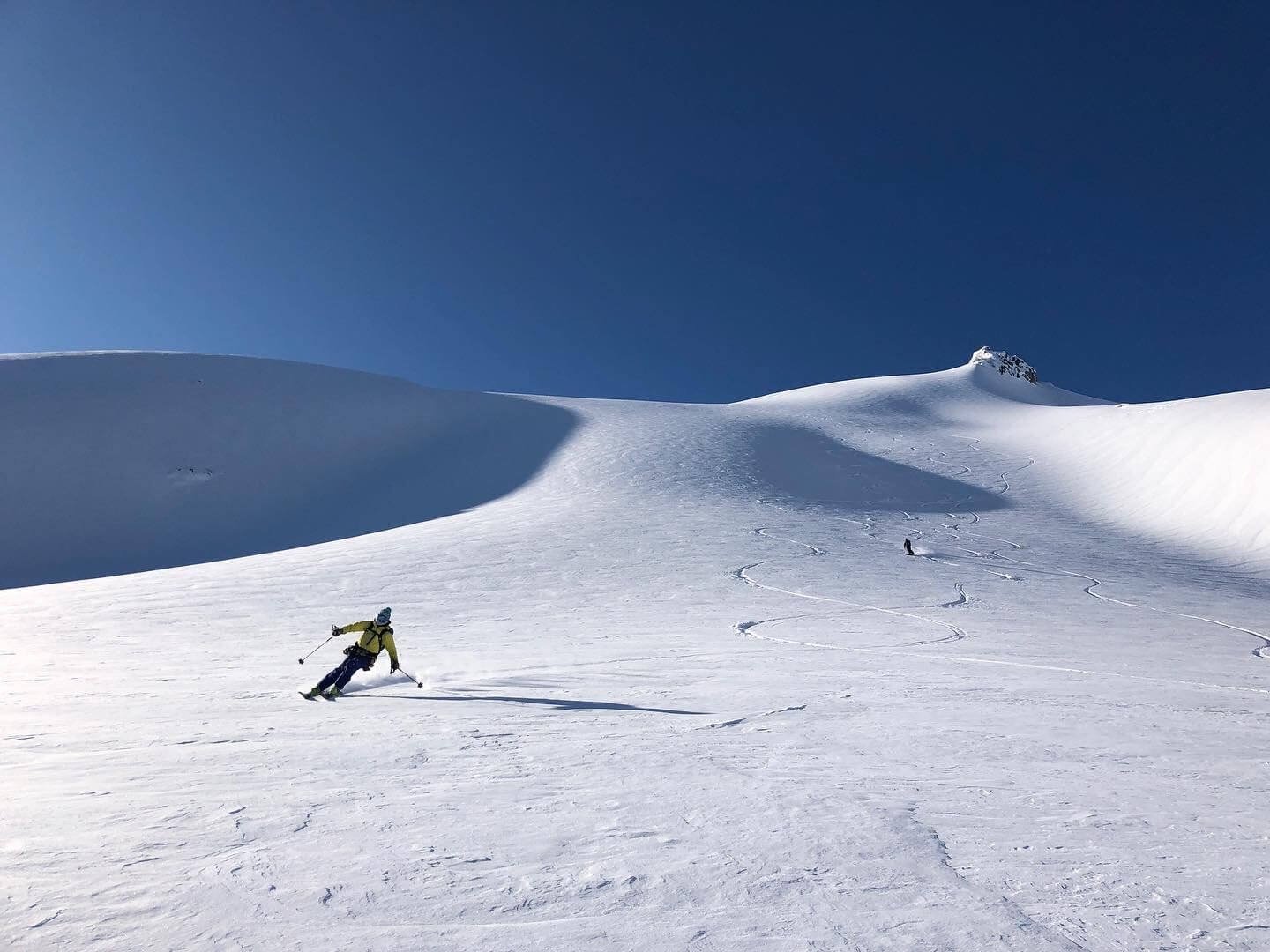
Haute Route
A World Class Ski Tour
For most people familiar with ski touring, there is no more well-known ski tour than the Haute Route, connecting the iconic ski towns of Chamonix, France and Zermatt, Switzerland. Each spring, Skyward Mountaineering and IFMGA guide, Steven Van Sickle travels to the Alps to lead this trip with seven days of world class skiing from the mighty Mont Blanc to the iconic Matterhorn. This trip is ski touring at its best - comfortable huts, delicious food, European amenities and excellent skiing in one of the world’s most scenic mountain settings. The Haute Route is one of the world’s finest ski traverses and should be on every backcountry skier's bucket list, it is a true journey that any dedicated backcountry skier wouldn’t want to miss.
Our trip includes seven days of skiing including a prep day in Chamonix on the famous Vallee Blanche, world class accommodations and food in six different huts between Chamonix and Zermatt.
Haute Route Itinerary
Day 0: Travel to Chamonix, France.
Day 1: Shakedown day - enjoy a day of skiing in the Vallee Blanche acclimating and practicing touring systems. Return to Chamonix for the night.
Day 2: Depart Argentiere and tour to Cabane du Trient.
Day 3: Tour to Mont Fort Hut.
Day 4: Tour to Prafleuri Hut.
Day 5: Tour to Dix Hut.
Day 6: Tour to Vignettes Hut.
Day 7: Ski down to Zermatt and celebrate your new friends and accomplishment with a traditional Swiss fondue dinner.
Participants must be advanced intermediate skiers with prior backcountry touring experience, be familiar with how to use all necessary ski touring equipment (including avalanche safety equipment) and be able to safely descend steep snow in varying conditions. They should also be fit enough to carry a 15 kg pack uphill for 4-6 hours a day at a steady pace for multiple consecutive days.
Geneva International Airport is located 45 minutes from Chamonix and just 3-4 hours return from Zermatt.
All lodging on the tour is in alpine huts. Participants are responsible for lodging prior ot the start in Chamonix and at the end of the tour in Zermatt.
All group equipment is provided by your guide. Skiers/riders are responsible for providing their own personal clothing and touring equipment. See recommended gear list below:
-
Long Underwear: Should be comfortable for a full day of activity, synthetic or merino wool will wick moisture away from the body
Ski socks: 2 pairs of over-the-calf winter weight for superior warmth. Layering two pairs of socks is not recommended as it may impede blood flow and make your toes colder
Warm hat
Sun hat
Buff: Lightweight neck gaiter for adding warmth around ears or covering your face in windy or sunny conditions
Softshell gloves: Waterproof with high dexterity. 2 pairs recommended, one midweight and one heavyweight.
Mittens: mid-weight leather are great for colder conditions. Can be used with heat packs.
Midweight top baselayer: Merino wool or synthetic fibers will wick sweat away.
Heavyweight bottom baselayer: Fleece pants are good and work well for hut attire.
Midweight fleece jacket: An integrated hood adds warmth and weather protection
Active insulation jacket: Ideal balance of breathability and warmth for winter aerobic activity
Midweight vest: Optional, adds warmth to your core without restricting movement
Softshell jacket: Midweight with a helmet compatible hood. Should have Durable Water Resistance (DWR) coating
Ski pants: Can be hard or soft shell depending on the conditions (hardshell are best for colder, stormy or winter conditions). Side vents are nice to extend the comfort range for warmth on ascents. Must fit over boot cuffs.
Insulated parka: Only necessary for mid-winter and very cold days. Down is lighter/more compressible and a hydrophobic treated down will insulate even when wet. Should have at least 200 grams of 800 fill insulation
-
Skis (or split board) with touring bindings: between 90mm and 115mm underfoot depending on snow type
Ski touring boots (split board boots must be hard boots)
Climbing skins fitted to skis; mohair or mohair mix is great, though full synthetic is fine.
Ski crampons compatible with bindings and skis
Adjustable poles (plus an extra basket)
Avalanche transceiver
Shovel
Avalanche probe
Ski helmet or climbing helmet
Day pack (30-40 liters) to carry extra clothes, helmet, water and food for the day (should have straps to carry skis)
Alpine boot crampons: capable of fitting onto ski boots.
Ice Ax: 45-60 cm; light weight for general mountaineering.
Alpine harness: Lightweight, ski mountaineering style preferred to easily put on with skis on.
-
Sunglasses: Dimmable recommended, CAT 3 lenses w/ athletic fit
Googles: Two pair recommended, one for low vis and another for sun/shade mix.
Small tube of sunscreen and SPF chap stick
First aid kit: Small, should include any personal medications and blister kit for feet.
Hand warmers: Optional, for those colder days
Fully charged phone and chargfing cord
2 liters of water: A thermos with your favorite hot drink is recommended. Avoid water bladders and hoses as they are prone to puncture and freezing in a winter environment
High energy lunch and snacks: A healthy mix of fats, sugar, and protein for a full day of the on-the-go (leftover pizza or sandwiches are a great midday pick-me-up)
Sattelite communication: InReach, optional.
Small headlamp
Important: Let us know what you DO NOT have, we may have it.
Check out our blog posts on Hut Based Ski Touring:
Includes:
7 days of guided backcountry skiing with an IFMGA Guide
Group ski mountaineering equipment (ropes and anchor material)
Lodging in mountain huts during the Haute Route tour
Meals at the huts (5 nights) during the tour
Lift tickets associated with standard itinerary
Does Not Include:
Additional expenses associated with a change in the itinerary
Travel to/from Chamonix/Zermatt
Lodging in town before and after the tour
Meals in town
Alcohol and bottled drinks
Guide gratuity


